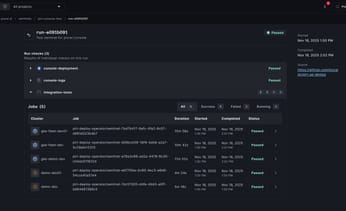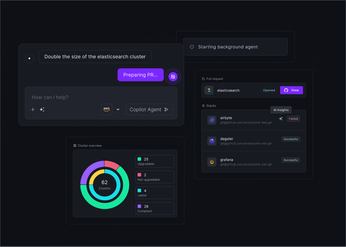
CycloneDX and SPDX for Kubernetes: A Practical Guide to SBOMs
Get a clear, practical overview of CycloneDX and SPDX for Kubernetes, with actionable steps to implement SBOMs and improve your software supply chain security.
For platform teams managing Kubernetes at scale, the software supply chain is a significant source of risk. Every container image deployed across your clusters is composed of hundreds of open-source and third-party components, creating a large and often opaque attack surface. A Software Bill of Materials (SBOM) brings visibility by cataloging every library and module in use. Beyond being a security best practice, SBOMs are increasingly mandated for compliance.
This article explains how to integrate SBOMs into your Kubernetes workflows and focuses on choosing the right standard. We'll compare the security-focused CycloneDX with the compliance-oriented SPDX, helping you determine which format best aligns with your security and regulatory needs.
Unified Cloud Orchestration for Kubernetes
Manage Kubernetes at scale through a single, enterprise-ready platform.
Key takeaways:
- Use SBOMs for proactive vulnerability management: An SBOM provides a complete inventory of every component in your Kubernetes workloads, allowing you to instantly identify all affected services when a new vulnerability is disclosed and shift your security posture from reactive to proactive.
- Automate SBOM generation in your CI/CD pipeline: To ensure accuracy and relevance, integrate SBOM generation and scanning directly into your build process. This creates an automated security gate that provides immediate feedback and prevents vulnerable code from being deployed to production.
- Standardize your tooling and formats for scale: Choose a single format (like CycloneDX for security or SPDX for compliance) and use a central platform like Plural to orchestrate your SBOM tools. This ensures consistent security and compliance policies are applied across your entire fleet of clusters.
What Is an SBOM?
An SBOM is a structured, machine-readable inventory of all components, libraries, and modules that make up a software artifact. Think of it as an exhaustive ingredients list for your application. SBOMs capture not only direct dependencies but also transitive ones—the dependencies of your dependencies—giving a full, hierarchical view of your software stack. Each entry typically includes the component name, version, supplier, and license information.
The purpose of an SBOM is to provide complete transparency into your software. In Kubernetes environments, where applications are assembled from hundreds of open-source and third-party components, this visibility is critical. SBOMs use standardized formats like SPDX or CycloneDX, making the data consistent and easily consumable by security and compliance tools.
This transparency turns vulnerability response from guesswork into a precise, data-driven process. For example, when a critical issue like Log4Shell arises, teams with an SBOM can quickly identify all affected applications and containers. Without it, identifying vulnerabilities requires manual, error-prone searches that leave systems exposed.
Why SBOMs Matter for Kubernetes Security
Kubernetes supply chains are complex due to the distributed and dynamic nature of containerized workloads. Each container image carries its own dependencies, and clusters can run hundreds or thousands of images simultaneously. SBOMs give teams the granular visibility needed to secure this ecosystem by providing a searchable inventory of every component across the fleet.
This inventory supports both security and compliance. SBOMs enable systematic tracking of vulnerabilities and software licenses at scale. When a new CVE is published, you can immediately query your SBOM repository to pinpoint affected workloads. Since dependencies and releases change constantly, updating SBOMs with every deployment ensures that your security posture reflects an accurate, real-time view of your software assets.
CycloneDX vs. SPDX: Choosing the Right SBOM Standard
When generating SBOMs for Kubernetes workloads, CycloneDX and SPDX are the two primary standards. Both offer structured formats for listing software components, but each was designed with distinct priorities. Selecting the right one depends on whether your focus is security, compliance, or a combination of both. The choice affects not just data formatting, but how effectively your SBOM supports operational workflows like vulnerability scanning or license auditing.
CycloneDX
CycloneDX is a lightweight SBOM standard developed by the OWASP community, emphasizing security. Its design prioritizes identifying and mitigating supply chain risks, making it highly effective for vulnerability management. CycloneDX captures the essential components of a software product in a streamlined format, allowing security scanners to efficiently detect known CVEs in container images and application dependencies. For platform teams focused on securing Kubernetes clusters, CycloneDX provides a lean, actionable approach to threat detection without unnecessary overhead.
SPDX
SPDX (Software Package Data Exchange) is a comprehensive standard created to manage software licensing and compliance. Recognized as an ISO/IEC standard (ISO/IEC 5962:2021), SPDX is ideal for organizations with strict regulatory or legal requirements. It supports multiple data formats—including JSON, XML, YAML, and tag-value—enabling flexible integration with various toolchains. While SPDX also addresses security, its detailed fields for licensing, file metadata, and package provenance make it particularly suited for enterprise-grade software asset management and ensuring open-source license compliance across Kubernetes workloads.
Choosing Between CycloneDX and SPDX
The right SBOM standard depends on your primary objectives. If security and efficient vulnerability scanning are your main concerns, CycloneDX’s focused, security-first approach makes it the better choice. If your priorities include rigorous license compliance, legal audits, or comprehensive tracking of all components, SPDX offers a more robust and standardized framework. Aligning the SBOM standard with your operational and compliance goals ensures that your Kubernetes deployments remain secure, transparent, and auditable.
How to Implement SBOMs in Kubernetes
Implementing SBOMs in a Kubernetes environment requires more than just picking a standard—it involves embedding SBOM generation and analysis into your software development lifecycle to maintain continuous visibility over your supply chain. The process centers on selecting the right SBOM format, automating its generation during builds, and feeding that data into security and compliance tools within your CI/CD pipeline. By treating the SBOM as a critical build artifact, you can track every component, detect vulnerabilities early, and maintain a secure posture across your containerized applications.
Integrate CycloneDX
CycloneDX is a lightweight SBOM standard optimized for security and supply chain analysis. Its machine-readable format and automation-friendly design make it easy to integrate into existing pipelines. A variety of open-source and commercial tools in the CycloneDX Tool Center support its generation. For example, GitHub Actions can automatically produce a CycloneDX SBOM for projects in Node.js, Python, Go, or Java. Once generated, the SBOM can be analyzed by dependency scanning tools to identify known vulnerabilities before the image reaches a container registry.
Configure SPDX
SPDX (Software Package Data Exchange) is a flexible SBOM standard that emphasizes license compliance alongside component and security information. It supports multiple output formats, including JSON, XML, YAML, and tag-value, allowing smooth integration with diverse toolchains. Teams can configure their SPDX tools to generate SBOMs in the format that aligns with their existing processes. For instance, JSON output can be easily consumed in automated CI/CD workflows for vulnerability scanning and license checks.
Automate SBOM Generation
For SBOMs to be effective, they must be accurate and up-to-date. Manual generation is error-prone and impractical, making automation essential. Integrate SBOM creation into your build process so that a new SBOM is generated whenever an application or its dependencies change. This approach follows guidance from industry and government standards, such as the NTIA’s "Minimum Elements for an SBOM," which recommends machine-readable SBOMs in formats like CycloneDX or SPDX. Automated generation ensures a consistent and reliable inventory of your software components for ongoing security monitoring.
Integrate SBOMs into Your CI/CD Pipeline
The most impactful use of SBOMs comes from embedding them into CI/CD pipelines. A typical workflow looks like this: a developer commits code, the CI pipeline triggers a build, and an SBOM is generated alongside the application artifacts. The SBOM is then analyzed by security scanners for vulnerabilities, license compliance, and outdated dependencies. If critical issues are detected, the pipeline can fail the build, preventing unsafe code from reaching production. This integration acts as a security gate, providing immediate feedback to developers and ensuring that only verified, compliant code is deployed to your Kubernetes clusters.
Key Tools for Managing SBOMs
Choosing the right tools is critical for effectively implementing and managing SBOMs in your Kubernetes environment. The ecosystem is growing, with solutions available for every stage of the software lifecycle, from generation to vulnerability management. The key is to select tools that integrate seamlessly into your existing CI/CD pipelines and provide the automation needed to manage SBOMs at scale. A well-chosen toolchain not only helps you create and validate SBOMs but also turns them into actionable security intelligence for your platform and development teams.
Tools for Generation and Validation
The first step in any SBOM strategy is generating the document itself. This should be an automated part of your build process, ensuring the SBOM is always up-to-date with the latest dependency changes. Tools in this category are designed to inspect your codebase, container images, or filesystems and produce a detailed inventory in a standard format like CycloneDX or SPDX. For example, the CycloneDX Tool Center lists numerous utilities, including GitHub Actions that can build an SBOM for projects across various languages. The goal is to integrate SBOM generation directly into your workflow, so it runs every time you build or update an application, providing a consistent and reliable source of truth for your software components.
Tools for Security Scanning
Once you have an SBOM, you need to analyze it for known vulnerabilities. Security scanning tools consume SBOM files to check each component against vulnerability databases like the NVD or GHSA. A popular open-source option is Anchore's Syft, a CLI tool that generates an SBOM from container images and filesystems, which can then be scanned by its companion tool, Grype. Another tool, Kubeclarity, is designed for Kubernetes environments and can scan your runtime environment and import existing SBOMs to identify security risks. These tools are essential for transforming your SBOM from a simple inventory list into an active defense mechanism against security threats within your clusters.
How Plural Simplifies SBOM Management
Plural provides the orchestration layer to automate and standardize your entire SBOM workflow across your Kubernetes fleet. While Plural doesn't generate SBOMs directly, its GitOps-based continuous deployment engine is the ideal place to integrate generation and scanning tools. You can configure your deployment pipeline to automatically trigger a tool like Syft to generate an SBOM during the build stage. Subsequently, another step can use a scanner to analyze the SBOM for vulnerabilities before the application is deployed. By managing this process through Plural, you ensure that every deployment across every cluster adheres to the same security standards, with all configurations version-controlled in Git. This provides a consistent, auditable, and scalable approach to SBOM management.
Tools for Vulnerability Management
Effective security goes beyond a one-time scan; it requires continuous vulnerability management. Dedicated platforms help you manage the entire lifecycle of a vulnerability, from detection to remediation. Tools like Synopsys Black Duck and JFrog Xray integrate with your development pipeline to generate SBOMs and continuously monitor for new vulnerabilities, license compliance issues, and policy violations. They can also enrich SBOMs with VEX (Vulnerability Exploitability eXchange) data, which provides context on whether a vulnerability is actually exploitable in your environment. These comprehensive platforms help you prioritize risks and automate compliance, turning your SBOM data into a cornerstone of your long-term security strategy.
Overcoming Common SBOM Challenges
Implementing SBOMs is essential for securing your software supply chain, but it introduces operational challenges. Platform teams managing Kubernetes at scale must address dependency complexity, format inconsistencies, data accuracy, and operational scale to make SBOMs effective.
Manage Complex Dependencies
Kubernetes workloads often involve multiple layers of dependencies, including transitive ones, which complicates SBOM generation. Capturing every component—from base images to application libraries—requires robust tooling and automated dependency analysis. Without it, SBOMs can be incomplete or misleading, leaving security gaps. Integrating automated dependency scanning into your build process ensures all components are accurately tracked.
Handle Multiple SBOM Formats
SPDX and CycloneDX serve different priorities: SPDX focuses on license compliance, while CycloneDX emphasizes security and vulnerability management. Many organizations need to support both to satisfy regulatory, customer, or tooling requirements. Ensuring interoperability and consistency across formats is critical. Tooling should be format-agnostic or support easy conversion without losing metadata, allowing teams to adapt without reworking processes.
Maintain SBOM Accuracy
An SBOM reflects a specific point in time and becomes outdated as soon as a dependency changes. In fast-moving CI/CD environments, manual updates are impractical. Best practices, including NTIA guidance, recommend regenerating SBOMs whenever dependencies change. Automating SBOM creation within your build pipeline, ideally as part of a GitOps workflow, ensures every commit produces an up-to-date SBOM that mirrors the deployed application.
Scale Your SBOM Operations
Managing SBOMs across hundreds of microservices and multiple clusters is challenging. Manual tracking does not scale. To handle this, SBOM generation must be automated in builds and paired with a centralized system for storage, access, and analysis. Platforms like Plural provide unified visibility, enabling teams to query all SBOMs simultaneously and rapidly assess the impact of new vulnerabilities across the entire Kubernetes environment.
SBOM Best Practices
Generating an SBOM is only the first step; its value comes from integrating it into a proactive security strategy. A static SBOM stored in a repository provides limited protection. To secure your software supply chain effectively, treat SBOMs as dynamic tools that inform security decisions across the software development lifecycle. By standardizing processes, automating controls, and continuously monitoring components, SBOMs become an active defense mechanism for Kubernetes environments.
Automate Security Controls
Manual SBOM generation and analysis don’t scale. Embed security controls directly into your CI/CD pipeline so that every build automatically produces an SBOM, stores it with the release, and scans it for vulnerabilities and license compliance. This ensures a complete and accurate inventory for every software version. Platforms like Plural’s GitOps-based Continuous Deployment make this seamless, triggering SBOM generation on every commit and making security checks an automated part of the deployment process.
Establish Standardization Guidelines
Consistency is critical for managing SBOMs at scale. Without a standard format, SBOMs become difficult to parse, compare, and use with automated tools. Organizations should choose a uniform format—like SPDX or CycloneDX—and enforce its use across all projects. Standardization ensures that every SBOM contains required fields in a predictable structure, enabling interoperability with scanning, analysis, and monitoring tools. It also simplifies automation and allows platform teams to maintain a centralized view of software supply chain risk across all Kubernetes workloads.
Set Up Continuous Monitoring
Software security is never static. Dependencies that are safe today may be vulnerable tomorrow. SBOMs should be living documents, regenerated whenever dependencies change and continuously monitored against vulnerability databases. This approach ensures that you can quickly identify when a newly disclosed vulnerability affects a deployed application, enabling faster response and remediation.
Enforce Policies Automatically
With automated SBOM generation and monitoring in place, the next step is policy enforcement. Define rules to block builds or deployments that don’t meet security standards—for example, failing a build if the SBOM contains components with critical vulnerabilities (CVSS > 9.0) or unapproved licenses. The NTIA recommends generating an SBOM whenever a component is updated, providing a natural trigger for policy evaluation. Within Kubernetes, tools like OPA Gatekeeper—integrated via platforms like Plural—can enforce admission controls based on SBOM scan results, preventing vulnerable images from running in your clusters.
Related Articles
Unified Cloud Orchestration for Kubernetes
Manage Kubernetes at scale through a single, enterprise-ready platform.
Frequently Asked Questions
What's the real difference between an SBOM and a vulnerability scan? Think of it this way: a vulnerability scan is like a health check-up that tells you what's wrong with your application today. An SBOM, on the other hand, is the complete list of ingredients. When a brand new vulnerability is discovered tomorrow, you don't need to re-scan everything. Instead, you can simply check your SBOM inventory to see if you used that vulnerable ingredient anywhere, allowing you to find and fix the problem much faster.
Do I have to choose between CycloneDX and SPDX forever? Not at all. The best standard is the one that solves your problem right now. If your main focus is securing your code and integrating with vulnerability scanners, CycloneDX is a great, lightweight choice. If you have complex license compliance and legal requirements, the comprehensive nature of SPDX is likely a better fit. Many teams end up using tools that can work with or convert between both formats, so you can adapt as your needs change.
How often should we generate a new SBOM for an application? An SBOM is only useful if it's accurate, so it should be generated every time your software changes. The best practice is to make SBOM generation an automated step in your CI/CD pipeline. This means every time a developer commits code that triggers a new build, a fresh SBOM is created alongside it. This ensures you always have a precise inventory that matches the exact version of the application being deployed.
How can I integrate SBOMs without slowing down my CI/CD pipeline? This is a common concern, but modern SBOM tools are built for speed. They are designed to run as a quick, lightweight step within your existing build process. When implemented correctly, generating an SBOM and running a scan adds a negligible amount of time to your pipeline. The security payoff from catching a critical issue before it reaches production is well worth the few extra seconds in your build.
So, where does Plural fit into this process? Plural is the orchestration layer that makes your SBOM strategy consistent and scalable. While Plural doesn't generate the SBOM file itself, you use its GitOps-based continuous deployment engine to automate the entire workflow. You can configure your deployment pipeline to automatically run a generation tool, pass the SBOM to a security scanner, and enforce policies that block vulnerable code from being deployed. This ensures your security standards are applied to every application across your entire Kubernetes fleet.
Newsletter
Join the newsletter to receive the latest updates in your inbox.









